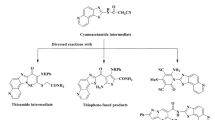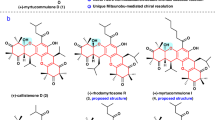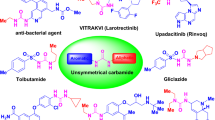Abstract
Xantholipin is a polycyclic xanthone antibiotic that exhibits potent cytotoxic and antibacterial activity. In this study, a new xanthone-type antibiotic, xantholipin B (1), was isolated for the first time along with its known derivative, xantholipin (2), from strain WJN-1, an aminotransferase inactivation mutant of the streptonigrin-producer Streptomyces flocculus CGMCC 4.1223. The structure of 1 was established based on spectroscopic analysis and supports the previously proposed biosynthetic pathway as a key intermediate of 2. Moreover, 1 showed 3- to 10-fold greater cytotoxicity than 2 against a select panel of human cancer cell lines. In addition, 1 demonstrated powerful antimicrobial activity against both Gram-positive bacteria and fungi. Importantly, both 1 and 2 inhibited the methicillin-resistant strain Staphylococcus aureus Mu50, with the MIC value of 0.025 μg ml−1. The new structural features of 1 enrich the structural diversity of xantholipin family compounds and shed new light on the structure–activity relationship of 1 as a promising antitumor drug candidate.
Similar content being viewed by others
Log in or create a free account to read this content
Gain free access to this article, as well as selected content from this journal and more on nature.com
or
Change history
06 December 2024
A Correction to this paper has been published: https://doi.org/10.1038/s41429-024-00796-2
References
Newman, D. & Cragg, G. Natural products as sources of new drugs over the 30 years from 1981-2010. J. Nat. Prod. 75, 311–335 (2012).
Luo, Y. et al. Engineered biosynthesis of natural products in heterologous hosts. Chem. Soc. Rev. 44, 5265–5290 (2015).
Luo, Y. et al. Activation and characterization of a cryptic polycyclic tetramate macrolactam biosynthetic gene cluster. Nat. Commun. 4, 2894–2899 (2013).
Scherlach, K. & Hertweck, C. Triggering cryptic natural product biosynthesis in microorganisms. Org. Biomol. Chem. 7, 1753–1760 (2009).
Aigle, B. & Corre, C. Waking up Streptomyces secondary metabolism by constitutive expression of activators or genetic disruption of repressors. Methods Enzymol. 517, 343–366 (2012).
Medema, M., Breitling, R., Bovenberg, R. & Takano, E. Exploiting plug-and-play synthetic biology for drug discovery and production in microorganisms. Nat. Rev. Microbiol. 9, 131–137 (2011).
Nett, M., Ikeda, H. & Moore, B. S. Genomic basis for natural product biosynthetic diversity in the actinomycetes. Nat. Prod. Rep. 26, 1362–1384 (2009).
Zerikly, M. & Challis, G. L. Strategies for the discovery of new natural products by genome mining. ChemBioChem 10, 625–633 (2009).
Terui, Y. et al. Xantholipin, a novel inhibitor of HSP47 gene expression produced by Streptomyces sp. Tetrahedron Lett. 44, 5427–5430 (2003).
Drautz, H., Keller-Schierlein, W. & Zahner, H. Metabolic products of microorganisms, 149. Lysolipin I, a new antibiotic from streptomyces violaceoniger (author’s transl). Arch. Microbiol. 106, 175–190 (1975).
Fukushima, K., Ishiwata, K., Kuroda, S. & Arai, T. Identity of antibiotic P-42-1 elaborated by Actinomyces tumemacerans with kanchanomycin and albofungin. J. Antibiot. (Tokyo) 26, 65–69 (1973).
Kobayashi, K. et al. Actinoplanones C, D, E, F and G, new cytotoxic polycyclic xanthones from Actinoplanes sp. J. Antibiot. (Tokyo) 41, 741–750 (1988).
Kobayashi, K. et al. Actinoplanones A and B, new cytotoxic polycyclic xanthones from Actinoplanes sp. J. Antibiot. (Tokyo) 41, 502–511 (1988).
Nakagawa, A., Iwai, Y., Shimizu, H. & Omura, S. Enhanced antimicrobial activity of acetyl derivatives of cervinomycin. J. Antibiot. (Tokyo) 39, 1636–1638 (1986).
Nakagawa, A., Omura, S., Kushida, K., Shimizu, H. & Lukacs, G. Structure of cervinomycin, a novel xantone antibiotic active against anaerobe and mycoplasma. J. Antibiot. (Tokyo) 40, 301–308 (1987).
Tanaka, H., Kawakita, K., Suzuki, H., Spiri-Nakagawa, P. & Omura, S. The mode of action of cervinomycin in Staphylococcus aureus. J. Antibiot. (Tokyo) 42, 431–439 (1989).
Winter, D. K., Sloman, D. L. & Porco, J. A. Polycyclic xanthone natural products: structure, biological activity and chemical synthesis. Nat. Prod. Rep. 30, 382–391 (2013).
Zhang, W. et al. Unveiling the post-PKS Redox tailoring steps in biosynthesis of the Type II polyketide antitumor antibiotic xantholipin. Chem. Biol. 19, 422–432 (2012).
Xu, F. et al. Characterization of streptonigrin biosynthesis reveals a cryptic carboxyl methylation and an unusual oxidative cleavage of a N-C bond. J. Am. Chem. Soc. 135, 1739–1748 (2013).
Hartley, D. L. & Speedie, M. K. A tryptophan C-methyltransferase involved in streptonigrin biosynthesis in Streptomyces flocculus. Biochem. J. 220, 309–313 (1984).
Gould, S. & Chang, C. C. Studies of nitrogen metabolism using 13C NMR spectroscopy. 1. Streptonigrin biosynthesis. J. Am. Chem. Soc. 100, 1624–1626 (1978).
Zou, Y. et al. Stereospecific biosynthesis of β-methyltryptophan from L-tryptophan features a stereochemical switch. Angew. Chem. Int. Ed. 52, 12951–12955 (2013).
Kong, D. et al. Identification of (2S,3S-β-methyltryptophan as the real biosynthetic intermediate of antitumor agent streptonigrin. Sci. Rep. 6, 20273–20281 (2016).
Mosmann, T. Rapid colorimetric assay for cellular growth and survival: application to proliferation and cytotoxicity assays. J. Immunol. Methods 65, 55–63 (1983).
Kumarasamy, Y., Cox, P., Jaspars, M., Nahar, L. & Sarker, S. Screening seeds of Scottish plants for antibacterial activity. J. Ethnopharmacol. 83, 73–77 (2002).
Sambrook, J., Fritsch, E. F. & Maniatis, T. Molecular Cloning: A Laboratory Manual Second EditionCold Spring Harbor Laboratory Press, Cold Spring Harbor, NY, (1989).
Kieser, T., Bibb, M., Chater, K. F., Butter, M. & Hopwood, D. Practical Streptomyces Genetics: A Laboratory Manual, (John Innes Foundation, Norwich, UK, (2000).
Gust, B., Challis, G., Fowler, K., Kieser, T. & Chater, K. PCR-targeted Streptomyces gene replacement identifies a protein domain needed for biosynthesis of the sesquiterpene soil odor geosmin. Proc. Natl Acad. Sci. USA 100, 1541–1546 (2003).
Acknowledgements
We thank Professor Lefu Lan at Shanghai Institute of Materia Medica CAS for technical support for the antibacterial assay and Professor Longhai Shen at China State Institute of Pharmaceutical Industries for performing the antitumor activity assay. We also thank the Instrumental Analysis Center of Shanghai Jiao Tong University and Shanghai Organic Chemistry for providing spectroscopic analyses. We are grateful to Dr Mostafa E Rateb for critical reading of the manuscript. This work was supported by grants from the National Natural Science Foundation of China (31425001 to SL; 31121064 to ZD) and grants from MOE of China.
Author information
Authors and Affiliations
Corresponding author
Ethics declarations
Competing interests
The authors declare no conflict of interest.
Additional information
Supplementary Information accompanies the paper on The Journal of Antibiotics website
Supplementary information
Rights and permissions
About this article
Cite this article
Wu, S., Huang, T., Xie, D. et al. Xantholipin B produced by the stnR inactivation mutant Streptomyces flocculus CGMCC 4.1223 WJN-1. J Antibiot 70, 90–95 (2017). https://doi.org/10.1038/ja.2016.60
Received:
Revised:
Accepted:
Published:
Issue date:
DOI: https://doi.org/10.1038/ja.2016.60
This article is cited by
-
Nocardia noduli sp. nov., a novel actinobacterium with biotechnological potential
Archives of Microbiology (2022)
-
Cervinomycins C1-4 with cytotoxic and antibacterial activity from Streptomyces sp. CPCC 204980
The Journal of Antibiotics (2020)



